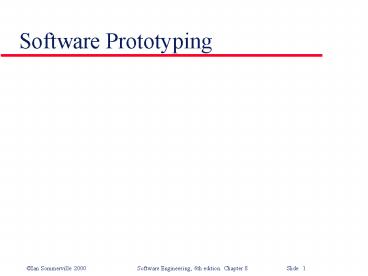Software Prototyping PowerPoint PPT Presentation
Title: Software Prototyping
1
Software Prototyping
2
System prototyping
- Prototyping is the rapid development of a system
- In the past, the prototype was normally thought
of as inferior in some way to the required
system, so further development was required. - Now, the boundary between prototyping and normal
system development is blurred and many systems
are developed using an evolutionary approach.
3
Uses of system prototypes
- The principal use is to help customers and
developers understand the requirements for the
system - Requirements elicitation. Users can experiment
with a prototype to see how the system supports
their work - Requirements validation. The prototype can reveal
errors and omissions in the requirements - Prototyping can be a risk reduction activity that
reduces requirements risks.
4
Prototyping benefits
- Misunderstandings between software users and
developers are exposed. - Missing services may be detected and confusing
services may be identified. - A working system is available early in the
process. - The prototype may serve as a basis for deriving a
system specification. - The system can support user training and system
testing.
5
Prototyping benefits
- Improved system usability
- Closer match to the system needed
- Improved design quality
- Improved maintainability
- Reduced overall development effort (?)
6
Prototyping in the software process
- Evolutionary prototyping
- An approach to system development where an
initial prototype is produced and refined through
a number of stages to the final system - Throw-away prototyping
- A prototype which is usually a practical
implementation of the system is produced to help
discover requirements problems and then
discarded. The system is then developed using
some other development process.
7
Prototyping objectives
- The objective of evolutionary prototyping is to
deliver a working system to end-users. The
development starts with those requirements that
are best understood. - The objective of throw-away prototyping is to
validate or derive the system requirements. The
prototyping process starts with those
requirements that are poorly understood.
8
Evolutionary prototyping
- Good for systems where the specification cannot
be developed in advance e.g., AI systems and
user interface systems - Based on techniques that allow rapid system
iterations - Verification is impossible as there is no
specification. Validation means demonstrating the
adequacy of the system.
9
Evolutionary prototyping
10
Evolutionary prototyping
- Specification, design and implementation are
inter-twined. - The system is developed as a series of increments
that are delivered to the customer. - Techniques for rapid system development are used
such as CASE tools and 4GLs. - User interfaces are usually developed using a GUI
development toolkit.
11
Evolutionary prototyping advantages
- Accelerated delivery of the system
- Rapid delivery and deployment are sometimes more
important than functionality or long-term
software maintainability - User engagement with the system
- Not only is the system more likely to meet user
requirements, they are more likely to commit to
the use of the system
12
Evolutionary prototyping problems
- Management problems
- Existing management processes assume a waterfall
model of development - Specialist skills are required which may not be
available in all development teams - Maintenance problems
- Continual change tends to corrupt system
structure so long-term maintenance is expensive - Contractual problems
13
Prototypes as specifications
- Some parts of the requirements (e.g.,
safety-critical functions) may be impossible to
prototype and so dont appear in the
specification. - An implementation has no legal standing as a
contract. - Non-functional requirements cannot be adequately
tested in a system prototype.
14
Incremental development
- System is developed and delivered in increments
after establishing an overall architecture - Requirements and specifications for each
increment may be developed - Users may experiment with delivered increments
while others are being developed. Therefore,
these serve as a form of prototype system. - Intended to combine some of the advantages of
prototyping, but with a more manageable process
and better system structure
15
Throw-away prototyping
- Used to reduce requirements risk
- The prototype is developed from an initial
specification, delivered for experimentation,
then discarded. - The throw-away prototype should NOT be considered
as a final system - Some system characteristics may have been left
out - There is no specification for long-term
maintenance - The system will be poorly structured and
difficult to maintain
16
Prototype delivery
- Developers may be pressured to deliver a
throw-away prototype as a final system. - This is not recommended
- It may be impossible to tune the prototype to
meet non-functional requirements. - The prototype is inevitably undocumented.
- The system structure will be degraded through
changes made during development. - Normal organizational quality standards may not
have been applied.
17
Throw-away prototyping advantages
- Increase in speed of delivery of the prototype
- No need to worry about documentation
- Can use rapid development tools that may not
normally be used for final product development - Can use any tool that will meet the need (the
prototype will be discarded) - Developers can concentrate heavily on eliciting
requirements from the client rather than on
actual software development.

